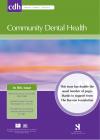Community Dental Health

- Cover Date:
- March 2011
- Print ISSN:
- 0265 539X
- Vol:
- 28
- Issue:
- 1
Community water fluoridation support and opposition in Australia
Objective: To estimate the level of support for water fluoridation across Australia and examine the association between water fluoridation stance and demographic and socioeconomic characteristics, commitment to the stance, and opinions, beliefs and knowledge regarding water fluoridation. Methods: Cross-sectional questionnaire data were obtained from 510 Australian adults (response rate = 34%) in 2008. Data were weighted by age, gender and state and territory estimated resident population. Main outcome measures: Participants were asked to rate the strength of their support for or opposition to water fluoridation on a 7-point scale. Results: Approximately 70% of survey respondents supported water fluoridation, 15.4% were opposed, and 14.5% were neutral. Those strongly opposed were most resistant to altering their opinion on the basis of new information or research. However, approximately 90% of people who were neutral, slightly supportive or moderately supportive would “maybe†or “definitely†change their stance. Fluoridation opposition was associated with lower income and educational attainment, more self-rated knowledge, and with beliefs about reduced benefits and greater harms. Opinions about who should be responsible for the introduction of water fluoridation and sources of information on fluoridation varied significantly by water fluoridation opinion. Conclusions: While this survey lends further weight to the evidence confirming extensive support for water fluoridation in Australia, a large percentage of the public may be open to changing their stance if presented with new information or research. To maintain the widespread acceptance of water fluoridation, it is important that the public are provided with unbiased and accurate interpretations of the continual stream of research related to fluorides and water fluoridation.
Key words: Attitudes, beliefs, public opinion, support, water fluoridation
- Article Price
- £15.00
- Institution Article Price
- £0.00
- Page Start
- 40
- Page End
- 46
- Authors
- H.F. Akers, J M Armfield
Articles from this issue
- Title
- Pg. Start
- Pg. End
- The caries experience of 5 year-old children in Scotland, Wales and England in 2007-2008 and the impact of consent arrangements. Reports of co-ordinated surveys using BASCD criteria
- 5
- 11
- The dilemma of selecting suitable proximal carious lesions in primary molars for restoration using ART technique.
- 12
- 16
- Using laser fluorescence (DIAGNOdent) in surveys for the detection of noncavitated occlusal dentine caries
- 17
- 21
- The prevalence of and risk factors for non-carious cervical lesions in adults in Hubei Province, China
- 22
- 28
- Health-related lifestyle behaviours, socio-demographic characteristics and use of dental health services in Greek adults.
- 47
- 52
- Periodontal health and treatment needs among hospitalized chronic psychiatric patients in Istanbul, Turkey
- 69
- 74
- Comparison of the COHIP and OHIP- 14 as measures of the oral health-related quality of life of adolescents
- 82
- 88
- Assessment and comparison of periodontal status among young smokers and nonsmokers of Bangalore, India - a cross sectional study.
- 89
- 94
- Smoking and drinking habits and attitudes to smoking cessation counselling among Tanzanian dental students
- 95
- 98
- Traumatic dental injuries to primary incisors and the terminal or occlusal plane relationship in Indian preschool children
- 104
- 106
- Teaching dental public health to undergraduates using community profiles and patient case studies
- 116
- 120
